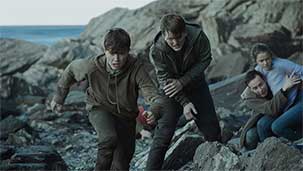You and your team were tasked with finding Norwegian actors to portray an event that shook not just Norway but the world; a homegrown terrorist attack that took the lives of 77 people, many of them teenagers, on July 22, 2011. Director Paul Greengrass’ oeuvre of dramatizing horrific events with his signature vérité style meant that casting was maybe the most important element in bringing this film to life.
With Norway’s relatively small population, some estimates have claimed that at least 1 in 4 Norwegian citizens knows someone directly impacted by the attacks. And 22 July succeeds in making the viewer feel like we know them too.
As with most Greengrass films, we begin with a day that feels the same as any other: young adults arriving at the island of Utoya, a Workers Youth League summer camp, eager to connect with old friends and meet new ones. In another remote location we see a man in a hazmat suit methodically mixing components for incendiary devices, then loading them into a van. A meeting at the Prime Minister’s office, in which he goes over a speech to be delivered to the kids at Utoya, ends with his staff dispersing to attend to other affairs of the state. It is this “business as usual approach that is meant to lull us into a false sense of security and illustrate just how quickly the mundane can escalate to sheer terror.
22 July is told in three acts – the terrorist attacks, the capture and mental assessment of Anders Behring Breivik (the white nationalist behind the attacks), and his highly publicized trial. In the first segment we meet Viljar, a promising and popular teen, his brother Torje, and their friends at Utoya. They attend a leadership seminar and play a game of soccer, Viljar flirts with a girl named Christian, trying to get their minds off of the news that there has been a suspected terrorist attack in Oslo, where many of their parents work. Greengrass doesn’t immediately pinpoint Viljar as one of the leads of the film, and Viljar, as played by Jonas Strand Gravli, doesn’t instantly stand out. And that’s the point. Breivik’s murderous plan is shocking and cruel in its randomness.
Breivik, played with smug sangfroid by Anders Danielsen Lie, arrives at the island of Utoya dressed as a police officer under the pretense of securing the island from further attacks. His spree is conducted matter-of-factly, as one might mow down opponents in a first-person shooter game. His arrest and detainment betray no sense of fear or disappointment. Danielsen Lie plays Breivik with precise tics and sneers, a man without remorse, but with significant identity issues. It’s never unclear that we’re dealing with a villain, but his portrayal makes for a complicated assessment – is he a paranoid schizophrenic? Does he suffer from severe narcissistic personality disorder? Is he simply a garden variety neo-Nazi with delusions of grandeur? His trial hinges on defining these terms, and Danielsen Lie doesn’t give anything away until he has to.
The counterpart to Breivik, is Viljar, a contemplative, reluctantly brave young man who is now reckoning with rebuilding his body and his spirit. Viljar, his family and remaining friends are coming to terms with the aftermath of something so incomprehensible that would have, in less confident hands, be prone to sentimentality. Instead, Greengrass shows Viljar’s and the survivor’s journeys as a spectrum, with all the dimensions – fear, anger, despair, hope, helplessness – represented as they are lived, day-to-day, without any heavy-handedness or manipulation. The results of this banality of evil are depicted purposely and powerfully and are all the more chilling for it.
Greengrass is interested in exposing the quiet rise of nationalism, which, in 2011 was still considered fringe but has become increasingly popular across Europe with a creeping reemergence in North America. By using unknown (outside of Norway) actors, Greengrass succeeds in reminding us that evil can be shockingly commonplace. It happens to people that look like you and me, perpetrated by people that look like you and me. And if it can happen in an exemplary democratic country like Norway, it can happen anywhere.
Using Norwegian actors to tell their own story doesn’t just give 22 July authenticity, it attempts to give them control of their story (though some survivors have been less than enthusiastic of the film’s portrayal). But more importantly, 22 July means to sound a warning bell to shake us from complacency, and to encourage us to act against atrocity in any and every form.
Best,
Di







